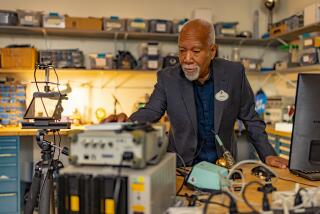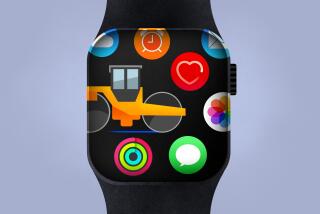The Mothers and Fathers of Invention : Creators Who Gamble on Gadgets and Tinker With Technology Walk Fine Line Between Genius, Crackpot
- Share via
Dr. Yoshiro NakaMats is an inventor, a venerable among crackpots and their solar-powered can openers. He is a millionaire lessor of his floppy-disk technology to IBM and holds more patents than Thomas Edison (2,360 to 1,033).
Daniel Fowler is an inventor, a raw beginner and a high school dropout among doctors and doyens . He has yet to sell any of his edible drinking straws loaded with tea, coffee or Kool-Aid pellets.
Extremes, yet consorts. Also representative of the infinite spectrum of human inspiration and mental perspiration that will gather at the Los Angeles Convention Center Friday for Invention Convention ‘87, a three-day meeting of minds, dreams, gadgets and life’s improvements.
NakaMats, 60, of Tokyo, will definitely be there. He is to speak and demonstrate his latest invention, a $70,000 reclining brain chair said to enhance memory, sexuality and creativity by giving the reclined a series of ultra-wave jump starts.
Fowler, 31, temporarily of Orofino, Ida., will definitely not be there. He’s barely halfway through a 15-year sentence for burglary. At a commutation hearing last year, a prison board denied his petition and its premise that with invention comes rehabilitation.
“But I have finally achieved something to show that I’m not a loser,” said Fowler in an interview via a public telephone at Idaho State Correctional Institution. In March, however, Fowler remained on a losing streak--the recipient of 20 days in solitary for making telephone calls to the media in violation of prison rules. “I’ve been told that my straws could earn anywhere between $2 million and $60 million. Figure 5 cents (his profit) on the dollar (of sales) of somewhere in the middle and that would make me $1 million a year.
“But that’s looking at it real good. It could also be a flop.”
Invention Fever
Transistor wishes and Cabbage Patch dreams, of course, are the raging fever of inventors. Hence events such as the Invention Convention (open to the public on the weekend) that will bring 300 inventor-exhibitors to Los Angeles.
And hence the Inventor’s Workshop International Education Foundation (40 chapters and 2,500 members in 10 countries) of Tarzana, the nonprofit group sponsoring the convention.
“This is the inventor’s opportunity to expose his product, to learn about patents and marketing, even to find the financing or production facility that will get his invention to the marketplace,” said Maggie Weisberg of Fort Jones, Calif., president emeritus of the workshop. “Corporate researchers. Buyers. Suppliers. Venture capitalists. Patent attorneys. They will all be there.”
From Dolls to Missiles
So will Jack Ryan of Santa Monica. He invented the Barbie doll and guidance systems for Sparrow and Hawk missiles. Terri Paul, with a double doctorate, will attend. She invented the one-mile cordless telephone. And NakaMats. He has refined everything from helicopter crop dusting through golf putters to that odd spelling of his name.
This, however, is Hall of Fame stuff. What of our Rube Goldbergs (UC Berkeley, Class of ‘04) and Thomas W. Crappers (yes, the one who invented manhole covers) and nutty professors next door?
“Well, we’ll be showing one invention that just might revolutionize the way we monitor electricity,” related Weisberg. “Each year, utility companies lose $6 billion to theft of electricity. This new meter will prevent theft by flagging, immediately, any unusual changes in the flow.
“Someone has invented an earthquake-proof dome that will convert an outdoor stadium for indoor events . . . also a hydrofoil surf board that allows you to fly over the waves in heavenly flight . . . a concept that uses the microwave principle for a hot-water heater . . . a high-rise fire escape, a little protective cage, that makes it possible to descend one floor at a time without going swoooosh zip, all the way down to the ground at once.”
According to convention planners, there are a myriad better mousetraps out there. Such as the Camper’s Cocoon that triples as a covered hammock, a lean-to and standard pup tent. Or the home heater fueled by ears of corn. Or an accelerator board to make an Apple computer work 200 times faster.
Many exhibitors, however, seem to have reinvented the wheel. Or at least the Rubik’s Cube and the corkscrew. The cube has been converted into an electronic game and the corkscrew now is wall-mounted and electrically operated.
Alarms are popular this year. One not only signals fire but also squirts water. Another is a clock and bedside lamp that flashes to awake the deaf. There’s also a device to make sure you don’t sleep through the Big One.
“It does not predict an earthquake,” said Gerold Baker of Westminster. “It doesn’t give you any kind of warning. But you can set it anywhere from zero to 8 on the Richter Scale and when the quake hits, the alarm will wake you up.
“I call it: ‘Wake Up with Quake Up.’ ”
According to Weisberg: “Only about 12% of all inventions will reach the market.”
Even a patent, said Charles Berman of Sheldon & Mack patent attorneys of Pasadena and West Los Angeles, is no guarantee of success. Each year, he said, there are approximately 120,000 patent filings.
“About 60% (of patent filings) are granted but those that really come to anything are very few,” said Berman. “I’d hazard a guess that 10% would be meaningful.”
The attorney, who will discuss patent pitfalls at Invention Convention, once handled an inventor who developed a champagne glass with a base light to color the champagne. It earned nothing.
Another client is a hematologist at Cedars-Sinai Medical Center who discovered a method of deactivating hepatitis and AIDS viruses in blood products. “That’s probably earning him $1 million a year,” said Berman.
Nobody quite knows who invented the phrase “necessity is the mother of invention.” Yet it remains a truism of the calling and the Invention Convention.
Richard Vreeken of Romoland, an 85-year-old retired, Dutch-born horticulturist, has two false hips and a frozen back. Necessity mothered his idea for a frame of vinyl-coated spring steel.
“With Easy On-Easy Off you can put socks on and take them off without bending down,” Vreeken explained. “It costs $22.50 and I’ve already sold it to veterans hospitals.”
Jean Pomerance, says husband Joe: “had this opinion that she was the messiest eater who ever wore spaghetti sauce or salad dressing . . . until our kids said: ‘Mom, what you need is a bib.’ ”
The Pomerances, operators of a Sherman Oaks pharmacy, are now marketing washable designer bibs for those uncomfortable moments at Spago. “Princess” comes in basic black with a white collar and pearls. “Engineer/Western” is stripes and a bandanna. “Tuxedo” looks as it sounds.
“They currently are on sale at the Hollywood Bowl, the Cedars-Sinai hospital gift shop and the Gourmet Shop at Disneyland,” said Pomerance.
Charles Hyte’s need seemed pretty evident after the third family accident. There had to be some way of removing the crunch from backing out of driveways. So Hyte--partnered by engineer Stewart Wilcox--borrowed a nifty idea from railroading and built an automobile-size turntable for private driveways.
“We’re aiming at (a price of) $5,000, which the average home owner can afford,” said Hyte, 68, a retired factory representative from Castle Heights.
If convict Fowler’s work does eventually produce commutation, it may be seen as a tribute to his skill at inventing a way out of prison.
An itinerant criminal since his teens, Fowler has tried everything to duck imprisonment. Five years ago, after being convicted of breaking into a pancake house, Fowler asked for the firing squad rather than 15 years. A year later, he volunteered to donate a kidney “to do something for society.”
Now it’s drinking straws.
Fowler says that with 15 years on his hands, there was plenty of room to expand a talent that may have begun when he was 14.
“I remember going into a local television station and saying: ‘Hey, why not put a disc jockey on TV?’ They said: ‘Get out of here, kid.’
“Now they call it MTV.”
He has toyed with the idea of felt pens loaded with Liquid Paper to avoid office mess and drip. There was his vest pocket toothbrush with toothpaste in the handle for unexpected dates after linguine lunches.
“Then I had this idea of a beverage-flavored straw that, unlike old straws, would not give the drink a sour taste,” he said. “Something that would come with a cartridge, gelatin capsules of compressed food products and flavored for soup, tea, coffee or Kool-Aid. You’d just put it in hot or cold water, depending on the beverage desired. For kids, I decided to make the straw edible. Taffy or licorice.”
It wasn’t easy trying to start a business in a prison that prohibits convicts from starting businesses. Most of Fowler’s tools and materiel were deemed contraband. He had to hide his prototypes.
“It was months of making something, getting it confiscated, getting back to it and getting it confiscated again,” he said.
The prison store yielded instant coffee, tea bags and soup powders that Fowler “melted into a mush, stuffed into a straw and then dried into pellets underneath a heater vent.”
To promote his product, Fowler joined Inventor’s Workshop International . . . and sold 40 pints of blood to pay for his $100 membership dues.
The workshop, said Weisberg, thought so much of Fowler’s straw it adopted the project and invested $2,500 in getting it patented.
Last year, at the group’s annual contest, Fowler’s flavored straw was named Invention of the Year.
He has a lawyer. He has a patent. Now all Fowler needs is freedom to pursue life and his inventions.
Imprisonment, he claims, has already cost him a small fortune. Several years ago, Fowler designed a piece of costume jewelry--a ladies watch in a ring.
“A company wanted to manufacture it,” he said. But his prison address effectively precluded business negotiations. “The company marketed the ring watch anyway. So even in here, someone will steal from you.”
For Yoshiro NakaMats the road has been longer but much softer. He has the education (an engineering doctorate from Tokyo University), the awards (from international expositions and his government) and the savvy to see a new challenge for today’s inventors.
“Now we must turn from products of easy living to the quality of human life,” said NakaMats in a telephone interview from Tokyo. “Since Edison, all inventions are just tools of people. The automobile is a tool to replace legs, to allow us to travel father, to make life easier.
“But they also make humans weak and hormones weak. So good inventions for humans should now be to enhance human performance.”
Cerebrex, he claims, will help build that performance.
It looks like a first-class airplane seat with a huge, hair-dryer hood. It faces a keyboard and computer terminal. A 20-minute catnap in Cerebrex, says NakaMats, is the equivalent of eight hours aboard a Simmons Beautyrest
NakaMats says there are 500 Cerebrex machines in use in Japan and he visualizes international chains of salons leasing units “for $100 or $200 a month” and serving a public hungry for rejuvenation.
“It supplies oxygen and nutrition to the human brain and then every function, such as sexual power, decision or memory power, eyesight will be much enhanced,” he said. “Sit 20 minutes in it and you can write better articles.”
Unlikely.
In a public demonstration, NakaMats took his brain chair to the front gates of Tokyo University. His subject was a student ready to take his medical exams.
The student failed.
More to Read
Inside the business of entertainment
The Wide Shot brings you news, analysis and insights on everything from streaming wars to production — and what it all means for the future.
You may occasionally receive promotional content from the Los Angeles Times.










